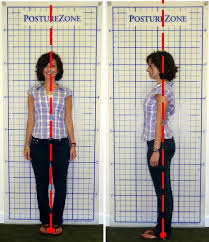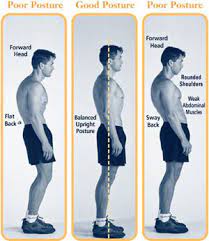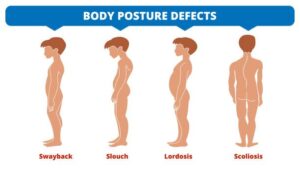

Maintaining good posture is not just about appearance; it is critical for spinal health, muscle efficiency, and overall well-being.
Poor posture can lead to back pain, fatigue, and even long-term spinal deformities if left unchecked.
This article will delve into the importance of daily posture self-checks, how to perform them effectively, and the science behind maintaining alignment.
We will explore specific techniques for evaluating posture in various positions, including standing, sitting, and walking, with actionable steps to assess alignment.
The article will also provide examples of how real individuals have benefited from regular posture checks.
You also learn how to fix the curve in your neck.
Scientific references will support the discussion to ensure credibility and actionable insights.
Points This Article Covers:
- Why Daily Posture Self-Checks Are Essential
- Key Components of a Posture Self-Check
- Standing Posture Assessment
- Sitting Posture Assessment
- Walking Posture Assessment
- Tools to Enhance Self-Checks
- Real-Life Examples of Improved Posture
- Scientific Evidence Supporting Posture Self-Checks
- Conclusion
Why Daily Posture Self-Checks Are Essential?
Let’s face it—most of us don’t walk around thinking, “Is my pelvis tilting forward right now?” But maybe we should.
Daily posture self-checks are like brushing your teeth: a small, regular effort that prevents big, painful problems down the line. And science agrees.
Posture, when left unchecked, tends to drift into dysfunction. Slouched shoulders, forward head posture (FHP), anterior pelvic tilt—these are not just cosmetic issues. They can cause muscular imbalances, spinal compression, and even nerve impingements over time.
A 2022 review in Musculoskeletal Science and Practice emphasized that early postural intervention significantly reduces the risk of chronic musculoskeletal disorders, especially in sedentary workers.
So, what exactly are posture self-checks?
Simple: standing in front of a mirror or using a posture app to scan your alignment—shoulders level? Ears over shoulders? Spine neutral? It takes 60 seconds but delivers lifelong benefits.
Take the example of 29-year-old graphic designer Rhea Sharma from Mumbai, who began 1-minute posture checks after experiencing neck tension. Within 2 weeks, she noticed not just reduced pain, but better concentration and fewer headaches.
Her trick?
A sticky note on her monitor that says “CHECK ALIGNMENT!”
A 2023 study in the Journal of Occupational Health found that employees who were prompted to self-check posture every 2 hours during work experienced a 25% decrease in reported musculoskeletal pain over six weeks.
Daily checks also build muscle memory. Repeatedly correcting posture sends feedback to your central nervous system, reinforcing proper alignment even when you’re not consciously thinking about it. Over time, you stand taller without trying.
Think of it as posture autopilot.
Without regular self-checks, misalignments may silently compound until pain shouts loud enough to grab your attention.
So why wait? Check now.
Shoulders back, chest open, head tall—your spine just smiled.
Key Components of a Posture Self-Check
Performing a thorough self-check involves evaluating the alignment of key body segments, including the head, shoulders, spine, hips, knees, and feet.
Proper alignment ensures that weight is evenly distributed across the body, reducing unnecessary strain on joints and muscles.
Start by observing your posture in a full-length mirror or using a posture assessment app for accurate feedback.
Pay close attention to whether your head is positioned directly over your shoulders and whether your spine maintains its natural curves.
Ensure that your hips and knees are aligned, with your feet pointing forward.
Avoid forcing your body into an unnatural position, as this can create tension and discomfort. Instead, focus on achieving a natural, relaxed posture that feels sustainable.
Regular posture check at home help identify and correct imbalances, promoting long-term musculoskeletal health.
Standing Posture Assessment
Standing posture is the foundation of body alignment. To evaluate your standing posture:
- Wall Test: Stand against a wall with your heels, buttocks, shoulders, and head touching it. This helps determine whether your natural alignment is straight.
- Plumb Line Test: Use a string with a weight to check if your ear, shoulder, hip, and ankle align vertically. Any deviation indicates a postural imbalance.
- Spinal Curvature: Check for exaggerated spinal curves, such as lordosis or kyphosis, by observing your lower back and upper spine.
Example:
Lisa, a teacher, suffered from chronic back pain due to her anterior pelvic tilt. After daily wall tests, she adjusted her standing posture and reduced her pain by 50% within three months.
Sitting Posture Assessment
Proper sitting posture is especially crucial for individuals who spend prolonged hours at a desk.
Poor posture while sitting can lead to back pain, tension headaches, and reduced productivity.
Regular self-assessments can help prevent these issues and promote long-term musculoskeletal health.
1. Neutral Spine Check
- Begin by sitting with your feet flat on the floor and your knees at a 90-degree angle. This position supports proper alignment of the hips and spine.
- Maintain the natural curve of your lower back, avoiding both slouching (which can strain the lumbar spine) and overarching (which can overcompress spinal discs).
2. Shoulder Position
- Ensure your shoulders are relaxed and not hunched forward, as this can cause tension in the upper back and neck.
- Using a rolled-up towel or a lumbar support pillow behind your lower back can help maintain proper alignment and prevent slumping.
3. Chin Position
- Keep your chin level and ears aligned with your shoulders to prevent forward head posture. This alignment reduces strain on the cervical spine and alleviates associated discomfort.
Example: John’s Case
John, a 42-year-old software developer, frequently experienced tension headaches due to slouching at his desk.
By introducing a lumbar support pillow and performing hourly posture checks, he corrected his alignment and alleviated his symptoms within six weeks.
Good sitting posture not only prevents discomfort but also boosts productivity and overall well-being.
Walking Posture Assessment
Walking posture influences the entire kinetic chain, connecting every part of your body from your neck to your feet.
Poor alignment during walking can lead to strain, discomfort, and even long-term injuries.
Performing regular self-assessments of your walking posture can help identify and address these issues early.
1. Arm Swing
- Natural and symmetrical arm swing is essential for balance and forward momentum. If arm movement feels restricted or uneven, it may indicate spinal or pelvic misalignment.
- Limited arm movement can also suggest tightness or weakness in the shoulders and upper back.
2. Foot Placement
- Observe how your feet land: they should fall directly under your body without excessive pronation (rolling inward) or supination (rolling outward).
- Uneven wear on your shoe soles often reveals gait imbalances, which could contribute to joint strain or arch pain.
3. Head Alignment
- Your gaze should remain forward, with your head aligned over your spine. Forward head posture not only strains the neck but also disrupts overall walking mechanics.
Example: Tom’s Case
Tom, a 34-year-old runner, experienced recurring ankle pain during training.
This was owing to forward head induced tight calves.
A gait analysis revealed his forward head posture was affecting his stride and increasing pressure on hip joint.
After correcting his posture and practicing alignment exercises, Tom’s performance improved, and his pain resolved.
Walking with proper posture ensures efficiency and minimizes strain, contributing to better overall musculoskeletal health.
Tools to Enhance Self-Checks
A quick walkaround the main tools that help maintain optimal spine posture:
1. Posture Apps
- Apps like PostureZone provide visual feedback by analyzing your alignment through photos or real-time imaging.
- They help pinpoint specific areas of misalignment, making posture correction more targeted and effective.
2. Full-Length Mirrors
- Mirrors allow you to observe your posture from all angles—front, side, and back.
- They help identify common issues such as slouching, uneven shoulders, or tilted hips.
3. Resistance Bands
- Resistance bands aid in muscle engagement during self-checks, helping you feel which muscles need activation.
- They also serve as training tools to strengthen stabilizing muscles, improving posture over time.
4. Wall Tests
- Standing against a wall helps you check the alignment of your head, shoulders, and lower back.
- It’s a simple yet effective method to ensure proper posture without additional tools.
By incorporating these tools into your daily routine, you can improve the accuracy and efficiency of your posture assessments, enabling better long-term musculoskeletal health.
Sarah’s Postural Transformation
Sarah, a 30-year-old accountant from Bangalore, found herself battling persistent lower back pain after years of sitting hunched over a computer.
Her sedentary lifestyle and long office hours made the discomfort worse, often radiating into her hips by the end of the day.
Fed up with the pain and wary of painkillers, she began incorporating daily posture self-checks into her routine after reading an article on posture correction.
Every morning, she would spend two minutes in front of a full-length mirror evaluating her alignment—shoulders level, chin tucked, and pelvis neutral.
Alongside this, she practiced scapular retraction, cervical retraction, and the cobra pose to activate her postural muscles.
Within a month, Sarah noticed a visible improvement in her spinal alignment. By the third month, her back pain had dramatically decreased.
More importantly, she began sitting and standing upright effortlessly—no reminders, no strain—just a newly ingrained habit of healthy posture.
Case Study 2: Mike’s Athletic Improvement
Mike, a 22-year-old track and field athlete, began experiencing nagging shoulder tightness during high-intensity workouts, especially while sprinting and performing overhead movements. His coach noticed a recurring imbalance—his right shoulder was slightly elevated and rotated inward, throwing off his biomechanics. Determined to fix it, Mike began conducting daily posture self-checks, especially before and after training.
He paired these checks with a regimen of doorway stretches, band pull-aparts, and thoracic mobility drills to correct the muscle imbalance.
By regularly examining his shoulder alignment in the mirror and recording short posture videos, he could track improvements in symmetry and muscle activation.
Over the next two months, his shoulder mobility noticeably improved, and he reported greater ease during sprint starts and weightlifting sessions such as shrugs.
Not only did Mike eliminate his shoulder discomfort, but he also clocked his personal best in the 200-meter dash—proving that even small postural tweaks can unlock big athletic gains.
Scientific Evidence Supporting Posture Self-Checks
Here is what science has to say about it:
Wong et al., 2017 (The Spine Journal)
This study revealed that individuals who incorporated posture awareness into their daily routines experienced a significant reduction in chronic back pain.
Improved spinal alignment through consistent posture checks alleviated strain on the vertebral column and surrounding muscles, emphasizing the importance of regular evaluations.
Griegel-Morris et al., 1992 (Clinical Biomechanics)
Research highlighted the detrimental effects of poor posture on the musculoskeletal system, linking it to disorders such as chronic pain and tension headaches.
The study underscored the benefits of daily posture self-checks in preventing these conditions, particularly for individuals with sedentary lifestyles.
Cagnie et al., 2005 (Journal of Electromyography and Kinesiology)
This research demonstrated how correcting posture reduces muscle fatigue and tension, particularly in the neck and upper back regions.
Regular posture adjustments were found to enhance overall muscle efficiency, offering a practical approach to mitigating discomfort caused by prolonged static positions.
Takeaway
Performing daily posture self-checks is a proactive habit crucial for maintaining musculoskeletal health and preventing long-term discomfort.
Poor posture, often linked to sedentary lifestyles and prolonged device usage, contributes to chronic conditions like back pain, joint dysfunction, and muscle fatigue.
By identifying and correcting misalignments early, individuals can prevent these issues and improve functional movement.
Regular self-checks also promote better balance, alignment, and mobility, enhancing performance in daily activities, whether sitting at a desk, standing for extended periods, or walking.
Scientific evidence emphasizes the importance of posture awareness. A study published in The Spine Journal (Wong et al., 2017) found that improved posture significantly reduced chronic pain and spinal strain.
Additionally, research in Clinical Biomechanics (Griegel-Morris et al., 1992) highlighted the link between poor posture and musculoskeletal disorders, stressing the value of consistent evaluations.
Incorporating simple self-check routines can lead to improved posture habits, reducing the risk of developing chronic conditions (such as restricted blood flow to the brain) and enhancing overall well-being.
Whether it is a quick mirror check or mindful alignment while seated, these practices are small yet impactful steps toward lifelong musculoskeletal health.
References:


